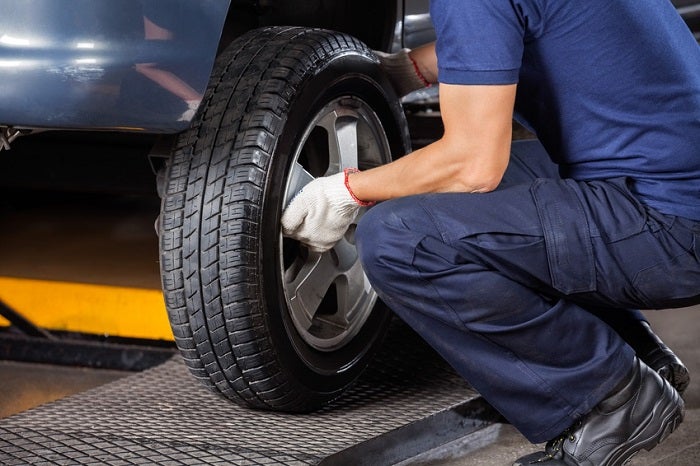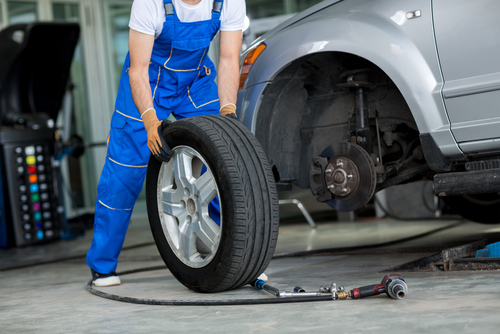Open Efficiency: Expert GMC Tire Service at Morris Tires
Open Efficiency: Expert GMC Tire Service at Morris Tires
Blog Article
Tire Solution: The Influence of Climate Condition
When it comes to guaranteeing optimal efficiency and safety on the roadway, comprehending the influence of climate problems on tire service is essential. GMC Tire Service. In this conversation, we will explore the intricate partnership between weather condition problems and tire service, dropping light on the significance of weather-specific tire maintenance practices and factors to consider.
Heat and Tire Efficiency
When revealed to high temperatures, tires experience adjustments in performance that can significantly impact automobile safety and security and handling. The warm created from prolonged driving or hot weather conditions triggers the tire rubber to soften, leading to minimized walk life and raised wear.

Cold Climate Impacts
Cold weather condition problems can have a considerable influence on tire performance and safety. As temperature levels drop, tire rubber can harden, leading to decreased traction on icy or snow-covered roads. In winter, tires might additionally lose air stress a lot more quickly, which can influence taking care of and fuel efficiency. Furthermore, chilly temperature levels can cause tire sidewalls to stiffen, enhancing the danger of damage from potholes or other road threats.
To reduce the effects of cold weather condition on tires, it is vital to consistently examine tire pressure and inflate them to the producer's advised levels. Making use of winter or all-season tires designed for winter conditions can additionally enhance grip and grasp on icy or snowy roads. Appropriate tire upkeep, including routine examinations for wear and damage, ends up being a lot more important during colder months to ensure ideal efficiency and safety.
Rainy Issues Influence
Throughout rainy problems, tire efficiency and safety can be considerably influenced by the damp roadway surface areas and decreased presence. The step pattern of tires plays an important duty in keeping traction on wet roadways. Tires with worn-out treads are extra vulnerable to hydroplaning, where a layer of water accumulates in between the road and the tire surface, resulting in loss of grip. To combat this, vehicle drivers should regularly inspect their tires for appropriate step deepness and her comment is here take into consideration investing in tires specifically designed for wet conditions.
Moreover, stormy climate can additionally lower exposure, making it testing for vehicle drivers to see the roadway ahead plainly (GMC Tire Service). In such problems, it is important to adjust driving rates appropriately and maintain a risk-free following distance to enable for abrupt quits. Properly filled with air tires can also help in maintaining control on damp roadways by supplying much better handling and grasp
Snow and Tire Safety
Snow-covered roadways posture special challenges for drivers, highlighting the value of proper tire selection and maintenance. When driving in snowy problems, having the appropriate tires can make a substantial distinction in security and efficiency. Wintertime tires are created with special rubber compounds and step patterns to supply better traction on snow and ice compared to all-season tires. The much deeper treads and sipes of winter months tires assist grip the roadway better, reducing the threat of slipping and moving.

Moreover, chauffeurs need to think about mounting tire chains in extreme snowy problems. Tire chains offer extra traction by gripping the snow and ice, enhancing stability and control. Nevertheless, it is very important to adhere to maker directions when making use of and setting up discover here tire chains to stop damage click to the tires and vehicle. By selecting the appropriate tires, preserving proper rising cost of living, and considering extra grip aids like tire chains, motorists can boost their safety and security when navigating snow-covered roadways.
Weather-Related Tire Maintenance
Weather-related tire upkeep encompasses a variety of practices intended at making certain optimum tire function and durability in different climate situations. One vital element of weather-related tire maintenance is tire stress law. Inspecting tire tread consistently and changing tires when step wear gets to a specific deepness is important for keeping grip and stability in negative weather condition.
Final Thought
In verdict, climate problems have a substantial impact on tire performance and safety and security. From warmth influencing tire pressure and put on to chilly climate lowering grip, it is vital to take into consideration the climate when maintaining and using tires.
In this conversation, we will discover the intricate connection between climate conditions and tire solution, losing light on the significance of weather-specific tire upkeep techniques and factors to consider.

Report this page